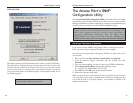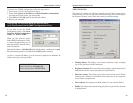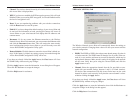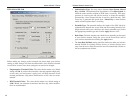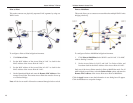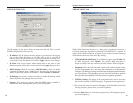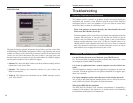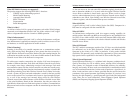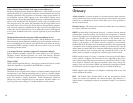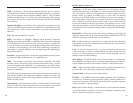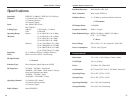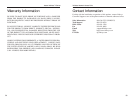
52
IP Address - In the most widely installed level of the Internet Protocol
(Internet Protocol) today, an IP address is a 32-binary digit number that identi-
fies each sender or receiver of information that is sent in packets across the
Internet. When you request an HTML page or send e-mail, the Internet
Protocol part of TCP/IP includes your IP address in the message (actually, in
each of the packets if more than one is required) and sends it to the IP address
that is obtained by looking up the domain name in the Uniform Resource
Locator you requested or in the e-mail address you're sending a note to. At the
other end, the recipient can see the IP address of the Web page requester or the
e-mail sender and can respond by sending another message using the IP address
it received.
IPCONFIG - A utility that provides for querying, defining and managing IP
addresses within a network. A commonly used utility, under Windows NT and
2000, for configuring networks with static IP addresses.
ISP - An ISP (Internet service provider) is a company that provides individuals
and companies access to the Internet and other related services such as website
building and virtual hosting.
LAN - A local area network (LAN) is a group of computers and associated
devices that share a common communications line and typically share the
resources of a single processor or server within a small geographic area (for
example, within an office building).
MAC Address - The MAC (Media Access Control) address is a unique num-
ber assigned by the manufacturer to any Ethernet networking device, such as a
network adapter, that allows the network to identify it at the hardware level.
mIRC - mIRC runs under Windows and provides a graphical interface for log-
ging onto IRC servers and listing, joining, and leaving channels.
Network Mask - also known as the “Subnet Mask.”
PCMCIA - The PCMCIA (Personal Computer Memory Card International
Association) is an industry group organized in 1989 to promote standards for a
credit card-size memory or I/O device that would fit into a personal computer,
usually a notebook or laptop computer.
Ping (Packet INternet Groper) - An Internet utility used to determine whether
a particular IP address is online. It is used to test and debug a network by send-
ing out a packet and waiting for a response.
Instant Wireless
TM
Series
DSSS - Also known as “Direct Sequence Spread Spectrum,” this is a variety of
radio transmission methods that continuously change frequencies or signal pat-
terns. Direct Sequence Spread Spectrum (DSSS), which is used in CDMA,
multiplies the data bits by a very fast, pseudo-random bit pattern (PN sequence)
that “spreads” the data into a large coded stream that takes the full bandwidth
of the channel.
Dynamic IP Address - An IP address that is automatically assigned to a client
station in a TCP/IP network, typically by a DHCP server. Network devices that
serve multiple users, such as servers and printers, are usually assigned static IP
addresses.
ESS - More than one BSS in a network.
FHSS - Also known as “Frequency Hopping Spread Spectrum.” Frequency
Hopping Spread Spectrum (FHSS) continuously changes the center frequency
of a conventional carrier several times per second according to a pseudo-ran-
dom set of channels, while chirp spread spectrum changes the carrier frequen-
cy. Because a fixed frequency is not used, illegal monitoring of spread spec-
trum signals is extremely difficult, if not downright impossible depending on
the particular method.
Firmware - Programming that is inserted into programmable read-only mem-
ory, thus becoming a permanent part of a computing device.
IEEE - The Institute of Electrical and Electronics Engineers. The IEEE
describes itself as “the world's largest technical professional society—promot-
ing the development and application of electrotechnology and allied sciences
for the benefit of humanity, the advancement of the profession, and the well-
being of our members.”
The IEEE fosters the development of standards that often become national and
international standards. The organization publishes a number of journals, has
many local chapters, and has several large societies in special areas, such as the
IEEE Computer Society.
Infrastructure - An infrastructure network is a wireless network or other small
network in which the wireless network devices are made a part of the network
through an Access Point that connects them to the rest of the network.
Wireless Network Access Point
53



